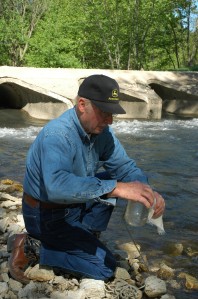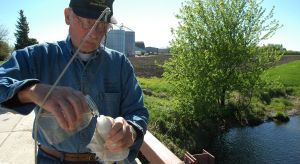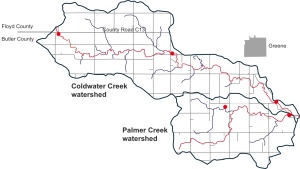GREENE — Lloyd Stauffer has a nearly proprietary interest in Lower Coldwater and Palmer Creek watersheds.
His family has lived on the same farm for 74 of his 75 years. Almost all of the farmland drains northeast into Coldwater; 5 acres near the farmstead drain to the south, under the road, into Palmer Creek.
“I guess I kind of know the creeks, I guess I’ve seen it all,” he says, more explanation than boast.
Lower Coldwater Creek sprawls across northern Butler County near Greene. Its course is easy to follow, defined by woodlands now green with new spring growth. Coldwater Creek begins near Rockwell and meanders about 24 miles (as birds fly) southeast to flow into the Shell Rock River near Greene; the Shell Rock is a tributary of the Cedar River.

Lloyd Stauffer fills a sample bottle with water taken from Coldwater Creek at site 2, Hickory Avenue in early May. The water sample is sent to the Iowa Hygienic Lab for testing. Stauffer has been gathering samples since 2006.
Lower Coldwater, about half the length of Coldwater, and Palmer Creek, a much smaller, losing stream that joins the former near where they enter the Shell Rock, are paired in a 39,120-acre watershed project now in its fourth year.
Both watersheds were designated as impaired in the 2004 list of Section 303(d) waters. The watershed council responded by electing to monitor the creeks initially at four sites.
Stauffer got involved after attending the council meeting: “I’m kind of interested in conservation,” he says. After discussing the issue with his wife, who has a background in biology and chemistry, he volunteered.
Since then has been traveling the blacktops and gravel roads, April through September, from the top of the watershed to the bottom to gather samples. He’s averaged eight trips each year.
Stauffer has a water sampling routine. Every two weeks, he contacts the University of Iowa Hygienic Lab in Iowa City for a testing kit, which arrives in a Styrofoam box about one foot square by 18 inches. Inside are six small glass bottles with labels and paperwork. This year, there are two new sites at a bioreactor installed last fall near the lower end he watershed.
Loading the sampling equipment into his Chevy pickup, he heads west on the gravel, over “Mt. Nebo,” a small but noticeable rise on the horizon that measures some 1,140 feet on a topographic map, then turns north to County Road C13 and northwesterly to a spot where Floydline Street crosses Coldwater Creek, the first sampling site.
Lloyd parks the pickup, takes a few minutes to pick out the correct sample bottle, grabs a larger mason jar tied to a long rope, then walks across the roadway to the south side of the bridge, where he drops the jar into the water, fills it with water and pulls it back up. The first jarful is a rinse so he drops the jar back down to the creek, fills it again and draws it back up; this time pours the sample into the smaller sample bottle.
Back in the pickup, he selects the corresponding paperwork for this sample, makes some notes, then starts the engine and heads downstream to the next sampling site.
Before we started the tour he offered a few comments about the sampling results on Coldwater: nitrate nitrogen sampling numbers are usually the highest at the upstream site, he says, then drop as the creek flows southeast. He speculates that the more intense farming upstream contributes to higher N numbers.
“As we go downstream there are more buffers and pasture,” he offers as an explanation. (Looking at satellite images, the upper part of the stream appears to have fewer trees while the lower half has more woods and wider riparian areas.) Palmer site, number 4, “usually runs about in the middle, maybe a little higher,” he says (in 2006 it was at the top with nitrate concentrations above 24 parts per million). Because Palmer is a losing stream, sometimes there are no samples to be taken – the creekbed is dry.
Sampling site 2, Hickory (named after the road), is heavily wooded as is Lacy (named after a nearby farmstead). Access at both is easy, though.
This year the initial nitrate numbers are much lower, 12 and 11 ppm instead of 17-20 at the beginning of the year. And Palmer Creek has been the lowest of the four.
A graph of the results resembles a map of the creek, in fact, sloping down from left to right. As remarkable, the average of all results show a decline in nitrate numbers since 2006, from near 25 ppm for Palmer to around 14-16 ppm for all four sites.
As he nears the Palmer and tile line sites, Stauffer spots Dennis Cassman, Coldwater/Palmer watershed council treasurer who installed the bioreactor last year on his farm. They discuss the bioreactor numbers, which are the lowest of the watershed after two test dates, and agree that it’s probably due to the April weather. “We haven’t had a lot of rain this year, yet.”

The Cassman bioreactor sites are down the road a bit, approachable by driving in the ditch to a waterway then down the waterway to the middle of the section. The bioreactor is less elaborate than earlier units installed in Coldwater/Palmer and other northeast Iowa watersheds; this one is about six by six by 100 feet, with a sampling tile line at the top and bottom. Water in the bioreactor drains from about 100 acres of cropland.
Stauffer lowers a cup attached to a fishing rod into the water and removes three cupfuls to fill a sample bottle.
When he’s finished taking samples and filling in paperwork, he heads back to his farmstead, where he repackages the Styrofoam container with samples and icepacks then heads to the post office in Greene to send the samples to the IHL. Some 10 days later, he gets the results which are entered into a computer spreadsheet program for later presentation to the watershed council.
In addition to providing numerical guidance for the watershed council, the results have provided spirited discussions, according to Chad Ingels, Iowa State University Extensions project advisor.
Nitrate sampling this year is funded by the Iowa Corn Growers, which also provided early funds to the watershed group. The Coldwater/Palmer watershed also received a grant from the Iowa Watershed Improvement Fund for a three-year project that ended last year.


Leave a comment